One New Mode of Transportation
Okay, not so much as a new way to travel but more a new experience of traveling (whick is of course why we are all here). 1. The Fix-it-as-you-go Bus. From Rio Dulce it is only an hour to Finca Paraiso and the hot waterfalls but the road is pretty terrible and consequently so are the busses. I´m guessing our bus had been a city transit some time in the early 80´s. She hadn´t aged gracefully. None of her gauges worked. Speedometer, tach, temp, fuel gauge all out. About 60% of her window were cracked and one was outright missing. The door was hinged by some strong canvas riveted to the door and the latch was definetly not factory orginal. When I looked into the overhead luggage racks I saw the supply of about 20 wire coathangers for reattching various hanging parts and when the bus bust a fuel line we got to see where the tools and spart parts were kept. All said it only took about 5 minutes to diagnose and fix the problem. The diagnosis was easy, the ayudante opened the engine hatch and we could all see the gas misting out. Replacing the line was like second nature to these guys. The driver took of his nice shirt, got dirty for a few minutes, hopped back in the seat and we were off like a shot. I´d definetly back the claim that the worlds best mechanics come from Central America and Mexico. Some elbow grease, wire, a piece of gum and 50 quetzals and you´re back on the road.-Dirk
Funniest Sight of the Week
A new segment for the blog: there are plenty of things that make us laugh every week so we´ll share the most ridiculous. This week was Smiles the Dog. Sarah and I and some RandomFriends from Livingston were hanging out in hammocks in a thatch hut at the end of a dock (insert Corona ad image here) when Smiles ran up to us. Smiles is brown and small and very happily enthusiastic. You can tell this guy loves affection. We all beckoned him over but Smiles has a twitch that has ruined his social life. Just before you pet Smiles he breaks into a huge doggie grin, not the kind where a dog´s open mouth looks cute and happy, but a full teeth bearing snarl. And the sad thing is he doesn´t mean it. We all tried to call Smiles over and get him to put away the teeth before we would pet him, but invariably he would eventually slink away not understanding why we´d called if we didn´t have anything for him. I tried to translate into human terms and decided Smiles was like a person with Tourette´s syndrom. He means well enough but these loud, body language outbursts make him really hard to hang out with. Plus, you can´t really help but laugh and that hurt his feelings.-Dirk
La Jungla and Tikal
Coming off all of our outdoorsy adventures in Lanquin, Sarah and I were ready to delve a little deeper and get even further off the "gringo trail." We headed north from Lanquin towards Flores, in El Peten, a city known mostly for being a traffic hub, a place to base your trips to the grand ruins of Tikal. The Peten area is huge and largely forested, only recently drawing much attention due to improved infrastructure and the wealth of Mayan ruins. We entered Flores thinking we would like to find a tour agency to organize a good long jungle expedition for us. We were hoping to hike to El Mirador, the two largest buildings discovered in the Mayan world, about a two day hike (one way) from the nearest small town. Our fantasy of being deep jungle explorers were dashed when we learned we would travel with 4 to 5 guides and a small army of pack horses. That and the trip would cost about what we spend here in a month. Not quite willing to give up on an jungle trek we explored some other options and found we could avoid the heavily traveled Flores to Tikal highway and hike from the small town of Cruce Dos Aguadas to a smaller ruin, El Zotz, and arrive in Tikal on foot, three days in all. Deciding that just one afternoon wouldn't do the ruins of Tikal justice we asked for an extension on our return bus ticket and packed up the tent and sleeping bag and hit the trail. We arrived at our first campsite after 5 hours of hiking on the first day. The day was nice and easy since our two pack horses carried all of the equipment and food, not to mention my pack with about 40 lbs worth of clothes and camping stuff. It dawned on us just how easy our trip was going to be as Carlos, our guide, and his helper set up camp and started cooking dinner refusing all help. I´d never been so pampered on a camping trip but Sarah and I just shrugged our shoulders and hung out with Selvin, Carlos´son who was with us on his last outing before school vacation ended. The hospitality and cooking couldn´t be faulted but whoever did the grocery shopping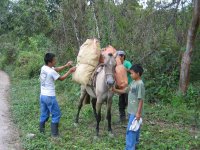 had purchased us a very "white trash" themed menu. Luckily Carlos caught on to the fact that we were much more into their tortillas than the processed white bread that was in such abundance (interesting note: here instead of Wonder Bread there is Pan Bimbo... are stupid names required for bad bread?). We started the next day with a fruit salad and a trip into the ruins of El Zotz. El Zotz is still mostly uncovered but you can gather the shape and size of the city because every hill in the area was an old stone building in a past age. Many looters have tunneled into the sides of these ruins and we passed through a few of the less invasive. The most thought provoking bit of El Zotz was the view from the top of their Temple 4. Across a large expanse of jungle you can see the top of Temple 4 in Tikal. It made me wonder what technologies the Mayans used to send messages between cities that were days apart. That afternoon we started out on the hike between the two cities. The jungle was filled with all sorts of fascinating plants and Carlos filled our minds with information as fast as we could receive it. If there weren´t plants with medicinal or ancient uses around Carlos would tell us some of the mythology of the jungle. It set a perfect tone for traveling long distances between ancient cities. After 3 hours of hiking our second day I dropped off quickly, dreaming of all the possibilities of the civilizations that had preceded us on this road. Our third and final day started early and without the horses. The horses and the fellow who minded them would head back the way we came and Carlos and Selvin would finish of the trip with us. The trek was a bit more difficult with 40 lbs on my back but the lush jungle was enough to distract me from my tired shoulders. We arrived at "Chico Tikal" about mid-day and ate a quick lunch (tuna fish on white bread and a Tang-like orange drink). Chico Tikal is a small one building ruin that has been a mid-point between El Zotz and Tikal for... 2500 years now? At least 1300. Three long days of hiking gave Sarah and I an entirely different feeling once we entered the Tikal ruins. We could see it for the center of commerce and religion it was. Our feet could feel a small part of the journey that so many Mayans would make to come to a bustling metropolis. It lent the ruins a gravity you c
had purchased us a very "white trash" themed menu. Luckily Carlos caught on to the fact that we were much more into their tortillas than the processed white bread that was in such abundance (interesting note: here instead of Wonder Bread there is Pan Bimbo... are stupid names required for bad bread?). We started the next day with a fruit salad and a trip into the ruins of El Zotz. El Zotz is still mostly uncovered but you can gather the shape and size of the city because every hill in the area was an old stone building in a past age. Many looters have tunneled into the sides of these ruins and we passed through a few of the less invasive. The most thought provoking bit of El Zotz was the view from the top of their Temple 4. Across a large expanse of jungle you can see the top of Temple 4 in Tikal. It made me wonder what technologies the Mayans used to send messages between cities that were days apart. That afternoon we started out on the hike between the two cities. The jungle was filled with all sorts of fascinating plants and Carlos filled our minds with information as fast as we could receive it. If there weren´t plants with medicinal or ancient uses around Carlos would tell us some of the mythology of the jungle. It set a perfect tone for traveling long distances between ancient cities. After 3 hours of hiking our second day I dropped off quickly, dreaming of all the possibilities of the civilizations that had preceded us on this road. Our third and final day started early and without the horses. The horses and the fellow who minded them would head back the way we came and Carlos and Selvin would finish of the trip with us. The trek was a bit more difficult with 40 lbs on my back but the lush jungle was enough to distract me from my tired shoulders. We arrived at "Chico Tikal" about mid-day and ate a quick lunch (tuna fish on white bread and a Tang-like orange drink). Chico Tikal is a small one building ruin that has been a mid-point between El Zotz and Tikal for... 2500 years now? At least 1300. Three long days of hiking gave Sarah and I an entirely different feeling once we entered the Tikal ruins. We could see it for the center of commerce and religion it was. Our feet could feel a small part of the journey that so many Mayans would make to come to a bustling metropolis. It lent the ruins a gravity you c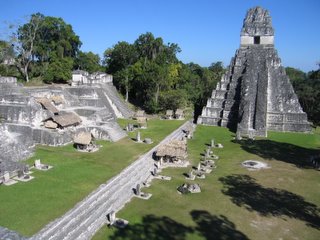 ouldn´t buy at the entrance. We ate a late lunch with Carlos and Selvin, said our goodbyes and pitched a tent. We spent the afternoon slowly meandering around the ruins, glad we had the whole next day to explore. We got on the sunrise bandwagon the next day, which involved getting up at 4:30 and bribing the guards (if twenty to thirty people do it everyday is it still called a bribe? maybe a payoff). We climbed Temple 4 and waited for the sun to make it´s appearance. Just before the sun tipped over the horizon all of the howler monkeys in the area of Tikal let loose with a greeting of the dawn aria. Amazing. We spent 12 hours running around Tikal; sketching, exploring, climbing countless stairs and enjoying quiet nooks all to ourselves. The Copan ruins were very finely carved and lovely but Tikal absolutely dwarfed them in size. I have seldom been as completely exhausted and entirely satisfied as I was at the end of this trip. A day or two to rest and it is on to Rio Dulce and the Carribean.-Dirk
ouldn´t buy at the entrance. We ate a late lunch with Carlos and Selvin, said our goodbyes and pitched a tent. We spent the afternoon slowly meandering around the ruins, glad we had the whole next day to explore. We got on the sunrise bandwagon the next day, which involved getting up at 4:30 and bribing the guards (if twenty to thirty people do it everyday is it still called a bribe? maybe a payoff). We climbed Temple 4 and waited for the sun to make it´s appearance. Just before the sun tipped over the horizon all of the howler monkeys in the area of Tikal let loose with a greeting of the dawn aria. Amazing. We spent 12 hours running around Tikal; sketching, exploring, climbing countless stairs and enjoying quiet nooks all to ourselves. The Copan ruins were very finely carved and lovely but Tikal absolutely dwarfed them in size. I have seldom been as completely exhausted and entirely satisfied as I was at the end of this trip. A day or two to rest and it is on to Rio Dulce and the Carribean.-Dirk
Some Adventures
After a couple rainy nights in Coban, Sarah and I trucked into Lanquin. Lanquin is a smallish town in Alta Verapaz, a large limestone plateau riddled with caves to explore. We made home base a lovely little lodge called El Retiro and took day trips from there. Being at El Retiro was a nice little vacation from all the work of traveling. The very gracious hosts have put together a comfy little compound on the shores of a river and most everything you could need is offered. There is laundry service, internet, books, music, tours and a lovely restaurant and bar that serves dinner family style with one large seating at 7:30. In Guatemala trying to find any one of these things can be a headache so having them all in one place where English is spoken was a real treat. I almost felt guilty for having it so easy. Almost. We took advantage of the tours that El Retiro offered and hit all the spots that make this area a destination. We started with some easy caving at Las Grutas de Lanquin. The Lanquin caves are over 11km long and have an immense underground river. A large part of the caves remain unmapped and unexplored. We went with a guide and didn´t stray far from the well lit concrete path. We did venture a bit past the constructed trail and got into some huge bat chambers and a good perch to view the river thundering by but as usual I wanted more. Caves always urge me on the dig further, deeper. I got my wish the next day. As part of our tour out to Semuc Champey we stopped by the Kan´ba caves. The Kan´ba caves involved a lot of climbing, ducking, twisting and scariest of all, swimming. We entered the caves in a group of about 10, with the light from 9 candles and the guides headlamp. In the middle of swimming (one handed because of my candle) down a long tunnel I was hit with a thought of, "I can´t believe I am doing this... I can´t believe I am PAYING to do this." Momentary panic aside the entire experience was amazing. Dark water has long been a fear of mine and forging into the ground to conquer my fears was very rewarding. The feeling of rebirth as we emerged from the caves was especially gratifying. We continued on to Semuc Champey, the last cave on our tour.  You can´t enter the cave here because it is filled with a roaring river. The attraction at Semuc Champey is the natural limestone bridge that is over the river and has about a dozen lovely blue-green pools, multiple waterfalls pouring from each pool to the next. We basked and bathed for the remainder of the day. A perfect way to unwind after an adventurous couple of days.-Dirk
You can´t enter the cave here because it is filled with a roaring river. The attraction at Semuc Champey is the natural limestone bridge that is over the river and has about a dozen lovely blue-green pools, multiple waterfalls pouring from each pool to the next. We basked and bathed for the remainder of the day. A perfect way to unwind after an adventurous couple of days.-Dirk
Two More Ways to Get Around
By public transport, that is...1. Tuk Tuk. Yes, the tuk tuk has entered Guatemala with a vengeance, and every city we've been to so far has tuk tuk taxis, and they call them tuk tuks! They're called moto-carros in Mexico, which is way more descriptive, since it is basically what you'd get if you bred a motorcycle with a car. Anyway, they're fun to take around town, but more expensive than the...
2. Pickups. The pickups ply all the main streets in small towns, and even between towns as far apart as 150 km. In Santiago, the pickups are regular Toyotas, or other familiar pickup, but as we've traveled farther east and north, the pickups have gotten bigger, and some of them around Lanquin were full on trucks, with a bed nearly 20 feet long. All versions of the pickup transport have had a frame over the bed, like the collectivos in Mexico minus the tarp. More people pack into the pickups than I could possibly imagine, as many as 20 people crammed in, with the truck riding so low on its tires that the slightest bump causes it to hit bottom, and the more adventurous riders hanging onto the outside of the frame with their feet on the bumpers.-Sarah
Antigua
Antigua is the colonial capitol of Guatemala, situated at the junction of four volcanoes, two of them active. They moved the capitol from Antigua to Guatemala City after Volcan de Fuego erupted and buried half the old city in the 1700s. A good move, I think. Antigua is Guatemala's poster-child city, with red tiled roofs and colorfully painted buildings lining the cobbled streets. The central square has a fountain that rivals any I've ever seen, adorned with four mermaids holding their breasts and water squirting from their nipples. 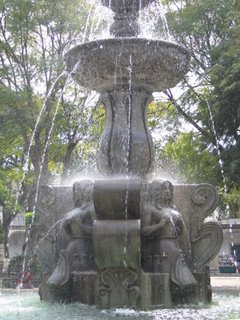 The city is strewn with ruins from the quake and eruption that prompted the change in capitol, you have only to walk a few blocks before coming across an abandoned church or monastery. 5th Ave is lined with trendy shops, and at the end is an arch that used to connect two convents - the nuns could cross the arch to get from one side to the other without being seen by anyone indiscreet, or anyone at all for that matter. We arrived in Antigua the 29th of December
The city is strewn with ruins from the quake and eruption that prompted the change in capitol, you have only to walk a few blocks before coming across an abandoned church or monastery. 5th Ave is lined with trendy shops, and at the end is an arch that used to connect two convents - the nuns could cross the arch to get from one side to the other without being seen by anyone indiscreet, or anyone at all for that matter. We arrived in Antigua the 29th of December 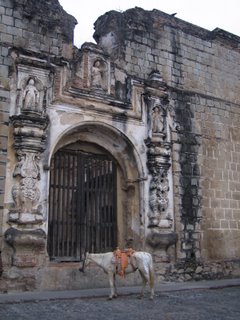 and stayed through the 3rd of January, so the city was full of tourists from all over the world there to celebrate New Years. It felt like the city was actually part of another country, with wealthy Guatemalans and other wealthy tourists (ourselves included) parading the streets, shopping, eating out, and generally not thinking about the poverty in the rest of the country. We took full advantage of our little tourist bubble and got a hotel room with cable TV, ate international cuisine, and shopped just like everyone else. New Years was full of fireworks, starting at dark and lasting well after midnight, fireworks were set off from three or four different points around the city, all near 5th Ave, where everyone was gathering to celebrate. In general, the fireworks in Antigua were much more predictable than those in Chichi, not a single one fired directly at the crowd. Marimba music played all night, and after several minutes of warning fireworks, the street would clear enough for a torito (the fireworks fused together on a frame resembling a bull) to dance and terrify the crowd. They also made toritos in the shapes of butterfly wings, with the fused fireworks in colored patterns out the length, with a finale of shooting fountains of sparks out the end of each wing. I ducked into a hotel doorway to hide from the last torito, music swelled in volume behind me, and suddenly materialized in to a band, ten or more stilt dancers, and other costumed figures, all reveling to a raucous salsa beat. A ten foot dancer cruised right by me, dressed in a tight white shirt with a white hood, red pants, face painted white with gold triangles extending up from his eyes and green patterns out the sides of his face. He danced by, head thrown back, eyes closed, hips swaying to the beat, and dancing the full on salsa footwork on his stilts. Whistles blowing, trilling ululations and beating drums, they paraded out into the streets. At midnight, with the street a sea of people, every person lit a gold sparkler and waved it over their head as a sign reading Bienvenido 2006 lit up in fireworks and a pinwheel torito exploded under the arch. I stayed out for the next three toritos, but a lingering case of food poisoning sent me to bed fairly early. After spending the next day recovering and watching movies, we greeted the new year with a hike up the still active volcano, Volcan Pacaya. Despite the assurances of the tour agent we bought the trip from that only five people were signed up so far, it turned out that every other tour operator sent their people on the same school bus as us, resulting in a crowd of about forty people hiking to the top together. For the first third of so of the hike, several locals followed behind us with horses saddled and ready to go, shouting at each break (of which there were many needed to accommodate 40 people) taxi! Pacaya taxi! The only challenge of the hike was the final ascent to the cinder cone, which is indeed composed of very small soft cinder rocks and sooty stuff, making the footing tough in addition to the strain of the altitude (about 7000 feet). Dirk skirted past everyone else, and by the time I next saw him, he was atop a hill creviced with smoking vents. The guide plopped down on a rock next to me, where I learned that he only makes forty quetzals (about 6 dollars) for each hike, even though each of us hiking had paid an agency around 50 quetzals per person. He sent around a hat at the end for tips, and I hope he did better off us than off INGUAT, the Guatemalan tourist center that manages the park. I also found out while we were talking that lots of people leave to work in the US, and that he wants to go too, but wants to go legally since he needs valve replacement surgery in his heart! All this and still climbing the volcano once or twice a day. We made it to the top together, slow and steady, to find a wonderland of smoking rocks, steaming vents, and at least two giant holes over 100 meters deep belching noxious sulfurous fumes that gave me flashbacks to organic chemistry labs in college. The sulfur turns the rocks near the edges of the holes bright toxic yellow, and some of the lava rocks are gold and iridescent silver, making the cone sparkle dangerously. The ground itself is hot there, as though to remind me of the boiling magma I'm sitting on, steam leaking out from under some of the rocks, mingling with the clouds rushing up the sides of the volcano. The descent was fabulous; Dirk and I took it at a full run, trusting the deep, soft cinder to moderate our speed with each footfall, not looking back until the ground suddenly hardened under us, and we sat down to empty our shoes and socks of the accumulated volcanic dust. Wheeeee! It was almost worth hiking up again for that sprint down. After such an early start, about five AM, and a vigorous hike, we spent the rest of the day recovering and finding ourselves a shuttle to Coban.
and stayed through the 3rd of January, so the city was full of tourists from all over the world there to celebrate New Years. It felt like the city was actually part of another country, with wealthy Guatemalans and other wealthy tourists (ourselves included) parading the streets, shopping, eating out, and generally not thinking about the poverty in the rest of the country. We took full advantage of our little tourist bubble and got a hotel room with cable TV, ate international cuisine, and shopped just like everyone else. New Years was full of fireworks, starting at dark and lasting well after midnight, fireworks were set off from three or four different points around the city, all near 5th Ave, where everyone was gathering to celebrate. In general, the fireworks in Antigua were much more predictable than those in Chichi, not a single one fired directly at the crowd. Marimba music played all night, and after several minutes of warning fireworks, the street would clear enough for a torito (the fireworks fused together on a frame resembling a bull) to dance and terrify the crowd. They also made toritos in the shapes of butterfly wings, with the fused fireworks in colored patterns out the length, with a finale of shooting fountains of sparks out the end of each wing. I ducked into a hotel doorway to hide from the last torito, music swelled in volume behind me, and suddenly materialized in to a band, ten or more stilt dancers, and other costumed figures, all reveling to a raucous salsa beat. A ten foot dancer cruised right by me, dressed in a tight white shirt with a white hood, red pants, face painted white with gold triangles extending up from his eyes and green patterns out the sides of his face. He danced by, head thrown back, eyes closed, hips swaying to the beat, and dancing the full on salsa footwork on his stilts. Whistles blowing, trilling ululations and beating drums, they paraded out into the streets. At midnight, with the street a sea of people, every person lit a gold sparkler and waved it over their head as a sign reading Bienvenido 2006 lit up in fireworks and a pinwheel torito exploded under the arch. I stayed out for the next three toritos, but a lingering case of food poisoning sent me to bed fairly early. After spending the next day recovering and watching movies, we greeted the new year with a hike up the still active volcano, Volcan Pacaya. Despite the assurances of the tour agent we bought the trip from that only five people were signed up so far, it turned out that every other tour operator sent their people on the same school bus as us, resulting in a crowd of about forty people hiking to the top together. For the first third of so of the hike, several locals followed behind us with horses saddled and ready to go, shouting at each break (of which there were many needed to accommodate 40 people) taxi! Pacaya taxi! The only challenge of the hike was the final ascent to the cinder cone, which is indeed composed of very small soft cinder rocks and sooty stuff, making the footing tough in addition to the strain of the altitude (about 7000 feet). Dirk skirted past everyone else, and by the time I next saw him, he was atop a hill creviced with smoking vents. The guide plopped down on a rock next to me, where I learned that he only makes forty quetzals (about 6 dollars) for each hike, even though each of us hiking had paid an agency around 50 quetzals per person. He sent around a hat at the end for tips, and I hope he did better off us than off INGUAT, the Guatemalan tourist center that manages the park. I also found out while we were talking that lots of people leave to work in the US, and that he wants to go too, but wants to go legally since he needs valve replacement surgery in his heart! All this and still climbing the volcano once or twice a day. We made it to the top together, slow and steady, to find a wonderland of smoking rocks, steaming vents, and at least two giant holes over 100 meters deep belching noxious sulfurous fumes that gave me flashbacks to organic chemistry labs in college. The sulfur turns the rocks near the edges of the holes bright toxic yellow, and some of the lava rocks are gold and iridescent silver, making the cone sparkle dangerously. The ground itself is hot there, as though to remind me of the boiling magma I'm sitting on, steam leaking out from under some of the rocks, mingling with the clouds rushing up the sides of the volcano. The descent was fabulous; Dirk and I took it at a full run, trusting the deep, soft cinder to moderate our speed with each footfall, not looking back until the ground suddenly hardened under us, and we sat down to empty our shoes and socks of the accumulated volcanic dust. Wheeeee! It was almost worth hiking up again for that sprint down. After such an early start, about five AM, and a vigorous hike, we spent the rest of the day recovering and finding ourselves a shuttle to Coban. 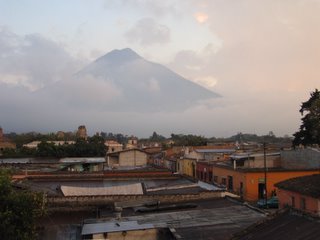 I was glad to be leaving Antigua; the city has the air of a place that's made for tourists and not for the Guatemalans who live there, a Disney-ified Guatemala with clean, bright streets and nothing behind the colorful facades...-Sarah
I was glad to be leaving Antigua; the city has the air of a place that's made for tourists and not for the Guatemalans who live there, a Disney-ified Guatemala with clean, bright streets and nothing behind the colorful facades...-Sarah
Copan Ruinas
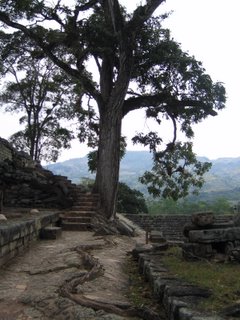 We awoke at 5 am on the 25th to get on a boat to Panajachel (also known as gringo-ville) to get on a shuttle to drive us for 6 hours across Guatemala to the Honduran border and just to the other side to the Mayan ruins of the great city of Copan. Half way across the lake, I notced some thin, cotton ball shaped clowds that I had high hopes for as the sun rose, and I wasn't dissapointed. On the far side of the lake, we were greeted by a spectacular sunrise which reached its peak at the exact moment we arrived at the look-out point maybe a kilometer above the lake. Small clouds dotted the entire eastern sky, each one fantastically pink, spread between towering volcanoes and reflected on the still morning water. Then we slept the rest of the way to Copan. Copan was a major Mayan center for only 400 years before the land was so depleted and the forests so demolished that they had to jump ship. The ruins stretch over 24 square kilometers, with three central plazas surrounded by towering pyramids with hundred year old trees growing out of them. We are greeted at the gates by a flock of tame macaws; their red, yellow and blue markings were sacred to the maya and represented the underworld, the world we live in and the heavens. In the ancient maya cosmology, everything in the physical world could be linked to the heavens or to the underworld with the help of the nobles, the priests or the king. They believed in the power the king and his connection with the cosmos so strongly that they considered him to be responsible for making the sun rise every morning. It was this kind of devotion that kept their society in its strict hierarchy - if the peasants didn't provide the food for the upper classes, it was entirely
We awoke at 5 am on the 25th to get on a boat to Panajachel (also known as gringo-ville) to get on a shuttle to drive us for 6 hours across Guatemala to the Honduran border and just to the other side to the Mayan ruins of the great city of Copan. Half way across the lake, I notced some thin, cotton ball shaped clowds that I had high hopes for as the sun rose, and I wasn't dissapointed. On the far side of the lake, we were greeted by a spectacular sunrise which reached its peak at the exact moment we arrived at the look-out point maybe a kilometer above the lake. Small clouds dotted the entire eastern sky, each one fantastically pink, spread between towering volcanoes and reflected on the still morning water. Then we slept the rest of the way to Copan. Copan was a major Mayan center for only 400 years before the land was so depleted and the forests so demolished that they had to jump ship. The ruins stretch over 24 square kilometers, with three central plazas surrounded by towering pyramids with hundred year old trees growing out of them. We are greeted at the gates by a flock of tame macaws; their red, yellow and blue markings were sacred to the maya and represented the underworld, the world we live in and the heavens. In the ancient maya cosmology, everything in the physical world could be linked to the heavens or to the underworld with the help of the nobles, the priests or the king. They believed in the power the king and his connection with the cosmos so strongly that they considered him to be responsible for making the sun rise every morning. It was this kind of devotion that kept their society in its strict hierarchy - if the peasants didn't provide the food for the upper classes, it was entirely 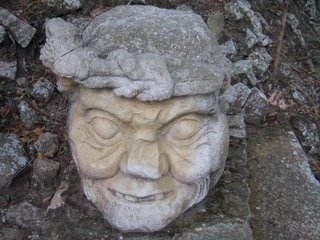 possible that the sun wouldn't rise again. There is one plaza in Copan surrounded on four sides by pyramid shaped temples. It used to be coated in stucco and painted red. There is a water main on one side and a drain on the other. When water was let in, the plaza was flooded with a shallow pool. Rising from the center rose another small pyramid. Archeologists surmise that they would flood this pool before dawn, where the stars would be reflected, thus symbolically bringing the cosmos down to the earth. The king would stand atop the central pyramid and usher in the rising of the sun. Imagine him dressed as the kings are carved on the stellae - jade breast piece, jade bracelets, tall crown, jaguar pelt hanging from loin to feet, boots made of jaguar with faces on each shin - arms outstreched to raise the sun from the underworld. And as the sun rises, the water in the pool is drained, the cosmos are gone into the underworld for the day and the king has lived up to his promise to raise the sun once again. The king also made promises that there would always be good harvests during each year of his reign, which led to occasional problems. One more ritual that took place in the same red stucco plaza is too morbid and interesting for me to resist describing. They have found two large stones carved with rounded bottoms and holes to support.... banners? With the rounded bottoms on the stucco floor of the plaza, they would have rolled. Another theory: The stones were part of a ritual for bringing fertility to the coming maize harvest, a ritual that coincided with the burning of the maize from the previous year's harvest. The holes in the stones would be used to support a scaffold onto which a prisoner, painted blue, would be tied. He would wear a backpack of pitch pine (a very incendiary form of pine tree). The floor below him would be covered in paper. Priests would shoot him with small arrows that would only superficially pierce the skin, allowing blood to drip onto the paper below but not kill the prisoner. This agony would cause
possible that the sun wouldn't rise again. There is one plaza in Copan surrounded on four sides by pyramid shaped temples. It used to be coated in stucco and painted red. There is a water main on one side and a drain on the other. When water was let in, the plaza was flooded with a shallow pool. Rising from the center rose another small pyramid. Archeologists surmise that they would flood this pool before dawn, where the stars would be reflected, thus symbolically bringing the cosmos down to the earth. The king would stand atop the central pyramid and usher in the rising of the sun. Imagine him dressed as the kings are carved on the stellae - jade breast piece, jade bracelets, tall crown, jaguar pelt hanging from loin to feet, boots made of jaguar with faces on each shin - arms outstreched to raise the sun from the underworld. And as the sun rises, the water in the pool is drained, the cosmos are gone into the underworld for the day and the king has lived up to his promise to raise the sun once again. The king also made promises that there would always be good harvests during each year of his reign, which led to occasional problems. One more ritual that took place in the same red stucco plaza is too morbid and interesting for me to resist describing. They have found two large stones carved with rounded bottoms and holes to support.... banners? With the rounded bottoms on the stucco floor of the plaza, they would have rolled. Another theory: The stones were part of a ritual for bringing fertility to the coming maize harvest, a ritual that coincided with the burning of the maize from the previous year's harvest. The holes in the stones would be used to support a scaffold onto which a prisoner, painted blue, would be tied. He would wear a backpack of pitch pine (a very incendiary form of pine tree). The floor below him would be covered in paper. Priests would shoot him with small arrows that would only superficially pierce the skin, allowing blood to drip onto the paper below but not kill the prisoner. This agony would cause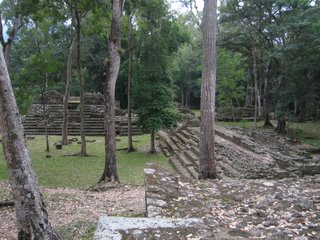 him to writhe, moving the round-bottomed stones, and grinding them on the stucco, creating a thundering noise throughout the plaza - imagine the colors, the red plaza, the paper covered in blood, the blue prisoner screaming and twisting on the scaffold. When it was the right time, the priests would lower him to the ground and burn both the prisoner and the papers, using the pitch-pine backpack as kindling. The maya gave their blood in honor to the gods, and also gave other people's blood, with and without their consent. This offering of blood was to ensure the fertility of the new crop, like an exchange, and it was burned to carry the offering up to the heavens. So, I've gotten this information from an interesting looking guy who my dad spotted touring the ruins with a group of Brits. He seemed to be the quintessential archeologist - wide safari hat, khakis, button-down short sleeve shirt, practical shoes, fishing vest (or probably an archeology vest, in which he kept schematics, blueprints, photos and maps) and to top it all off, he had glasses and a bushy mustache. And, as it turned out, he was one of the lead archeologists of a certain temple in the Copan ruins. I spotted my dad trailing this group around, and I set off with them too, to learn these gory and fascinating details of religious life, which was decidedly not separate from "secular life," in the height of the mayan empire. The current maya religion does include sacrificing chickens, but their way of life in this time (as a suppressed people, not the ruling poeples they were before the spanish conquest) is decidedly more peaceful, and has also incorporated catholicism without losing the mayan religion.-Sarah
him to writhe, moving the round-bottomed stones, and grinding them on the stucco, creating a thundering noise throughout the plaza - imagine the colors, the red plaza, the paper covered in blood, the blue prisoner screaming and twisting on the scaffold. When it was the right time, the priests would lower him to the ground and burn both the prisoner and the papers, using the pitch-pine backpack as kindling. The maya gave their blood in honor to the gods, and also gave other people's blood, with and without their consent. This offering of blood was to ensure the fertility of the new crop, like an exchange, and it was burned to carry the offering up to the heavens. So, I've gotten this information from an interesting looking guy who my dad spotted touring the ruins with a group of Brits. He seemed to be the quintessential archeologist - wide safari hat, khakis, button-down short sleeve shirt, practical shoes, fishing vest (or probably an archeology vest, in which he kept schematics, blueprints, photos and maps) and to top it all off, he had glasses and a bushy mustache. And, as it turned out, he was one of the lead archeologists of a certain temple in the Copan ruins. I spotted my dad trailing this group around, and I set off with them too, to learn these gory and fascinating details of religious life, which was decidedly not separate from "secular life," in the height of the mayan empire. The current maya religion does include sacrificing chickens, but their way of life in this time (as a suppressed people, not the ruling poeples they were before the spanish conquest) is decidedly more peaceful, and has also incorporated catholicism without losing the mayan religion.-Sarah









